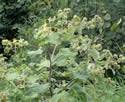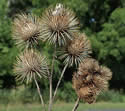Arctium lappa (Great Burdock)
| Also known as: | |
|---|---|
| Genus: | Arctium |
| Family: | Asteraceae (Aster) |
| Life cycle: | biennial, short-lived perennial |
| Origin: | Eurasia |
| Status: |
|
| Habitat: | part shade, sun; dry to moist disturbed soil; fields, ditches, open woods, woodland edges, waste areas, railroads |
| Bloom season: | July - September |
| Plant height: | 3 to 9 feet |
| Wetland Indicator Status: | none |
| MN county distribution (click map to enlarge): |  |
| National distribution (click map to enlarge): |  |
Pick an image for a larger view. See the glossary for icon descriptions.
Detailed Information
Flower: 



![[photo of flowers]](/udata/r9ndp23q/purple/arctium-lappa-great-burdock_0720_113654-t.jpg) Small clusters of stalked, thistle-like flower heads at branch tips and arising from leaf axils, usually loosely arranged in a flattish cluster. The 40+ disk flowers in each flower head are pinkish-purple to deep purple, occasionally white, with dark purple-tipped stamens surrounding a long white style. Surrounding the base of the flowers is a dense, broadly egg-shaped to round array of softly spiny bracts (phyllaries), the entire set (involucre) 1 to 1¾ inches (2.5 to 4.5 cm) diameter, sometimes sparsely covered in cobwebby hairs but usually hairless. Each phyllary is lance-linear with a tiny hook at the tip, the edges sometimes minutely serrated or with a few hairs. Flower stalks are 1 to ~2½ inches (2.4 to 6 cm) long.
Small clusters of stalked, thistle-like flower heads at branch tips and arising from leaf axils, usually loosely arranged in a flattish cluster. The 40+ disk flowers in each flower head are pinkish-purple to deep purple, occasionally white, with dark purple-tipped stamens surrounding a long white style. Surrounding the base of the flowers is a dense, broadly egg-shaped to round array of softly spiny bracts (phyllaries), the entire set (involucre) 1 to 1¾ inches (2.5 to 4.5 cm) diameter, sometimes sparsely covered in cobwebby hairs but usually hairless. Each phyllary is lance-linear with a tiny hook at the tip, the edges sometimes minutely serrated or with a few hairs. Flower stalks are 1 to ~2½ inches (2.4 to 6 cm) long.
Leaves and stems: 


![[photo of leaves]](/udata/r9ndp23q/purple/arctium-lappa-great-burdock_0801_142339-t.jpg) Leaves are basal and alternate. Basal and the lowest stem leaves are 10 to 30 inches (25 to 80 cm) long, half or more as wide, heart-shaped at the base, rounded to pointed at the tip, on solid stalks up to 14 inches (36 cm) long. Edges are wavy and toothless or minutely toothed; surfaces are gland-dotted and variably hairy. Leaves become smaller and shorter stalked as they ascend the stem, becoming stalkless and less wavy up into the flower clusters. Stems are single, usually much branched, stout but brittle, green or reddish purple, minutely hairy.
Leaves are basal and alternate. Basal and the lowest stem leaves are 10 to 30 inches (25 to 80 cm) long, half or more as wide, heart-shaped at the base, rounded to pointed at the tip, on solid stalks up to 14 inches (36 cm) long. Edges are wavy and toothless or minutely toothed; surfaces are gland-dotted and variably hairy. Leaves become smaller and shorter stalked as they ascend the stem, becoming stalkless and less wavy up into the flower clusters. Stems are single, usually much branched, stout but brittle, green or reddish purple, minutely hairy.
Fruit: 

![[photo of fruiting heads]](/udata/r9ndp23q/purple/arctium-lappa-great-burdock_0822_112342-t.jpg) At maturity, the persistent bracts dry to brown and become stiff, the hooks attaching the seed head to clothing, animal fur, and anything that passes by, spreading seed far and wide.
At maturity, the persistent bracts dry to brown and become stiff, the hooks attaching the seed head to clothing, animal fur, and anything that passes by, spreading seed far and wide.
![[photo of seeds]](/udata/r9ndp23q/purple/arctium-lappa-0821-s1-t.jpg) Seeds are light brown mottled with darker spots, 6 to 7.5 mm long. At the top is a tuft of light brown bristles 2 to 5 mm long that fall off as seed dries.
Seeds are light brown mottled with darker spots, 6 to 7.5 mm long. At the top is a tuft of light brown bristles 2 to 5 mm long that fall off as seed dries.
Notes:
Burdock is a tenacious weed with a massive taproot that does not respond well to herbicide control, plus it has a persistent seed bank. The hooked phyllaries are reputed to be the inspiration for Velcro™. The fruiting heads persist through winter and walking through a patch in early spring can bring you misery.
Great Burdock may or may not be a relative newcomer to Minnesota. In any case, it is likely very under-reported in the state and I wasn't even aware of the species myself until relatively recently. As of this writing there are only 5 herbarium records, but hundreds of observations on iNaturalist, though many of those are suspect as they lack images of characteristics that are needed for a positive ID. It is easily confused with Common Burdock (Arctium minus), and in the past I pretty much ignored Burdock assuming everything was A. minus, but have recently concluded that I've likely encountered A. lappa just as often, if not more.
A few things set A. lappa apart from A. minus: the flower and fruiting heads are much larger, usually distinctly more than 1 inch diameter, and their stalks are relatively long so the clusters are loose and flattish, where A. minus flower/fruit heads are more often 1 inch or less in diameter and stalks are shorter, the flower clusters usually compact. When flowers or fruits are not present, the stalks on basal and lower stem leaves are key, which are solid on A. lappa where A. minus stalks have a hollow core.
The third Arctium species in Minnesota is Woolly Burdock (A. tomentosum), which has the smaller flower/fruit heads of Common Burdock combined with the longer stalks of Great Burdock; leaf stalks can be solid or hollow. Its distinctive characteristic is the phyllaries densely covered in cobwebby hairs, though hairs can thin out with age. Its leaves are also said to be generally more densely white hairy on the lower surface where the other two are less densely gray-hairy, but I've found any of these can have white or gray hairy leaves at some point so it is not a very reliable characteristic. As it happens, all three species are conveniently located in a city park near me.
Native Plant Nurseries, Restoration and Landscaping Services ↓
More photos
 Great Burdock plant
Great Burdock plant Great Burdock plant
Great Burdock plant Great Burdock plant
Great Burdock plant flower heads are long-stalked in more or less flat-topped clusters
flower heads are long-stalked in more or less flat-topped clusters comparison of Arctium minus and A. lappa lower leaf stalks
comparison of Arctium minus and A. lappa lower leaf stalks comparison of Arctium minus and A. lappa flower clusters
comparison of Arctium minus and A. lappa flower clusters comparison of Arctium minus and A. lappa fruiting clusters
comparison of Arctium minus and A. lappa fruiting clusters A. minus, A. tomentosum and A. lappa flower heads.
A. minus, A. tomentosum and A. lappa flower heads.
Photos by K. Chayka taken in Dakota and Ramsey counties.
Comments
Have you seen this plant in Minnesota, or have any other comments about it?






